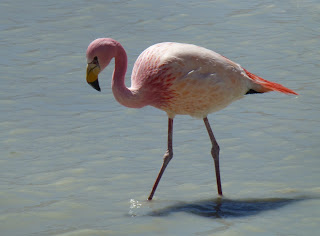Following my work assignment in Bolivia earlier this year, I now had the opportunity to go there on holiday. So a small group of us - five Brits and one American woman who doesn't like travelling with other Americans - met up with eachother and our guide in the south-eastern city of Santa Cruz to start our trip.
The first part of the trip was an experiment for the tour company, a visit to the pre-Incan hilltop site of El Fuerte followed by a couple of days following the "Ruta del Che" around the countryside. Che Guevara went to Bolivia as a good central place from where he could catalyse revolutions in various parts of South America. However, as with his earlier venture into Central Africa, this was not well planned. At least some of the peasants accepted his message, but the welcome he'd anticipated from the local communist party was not forthcoming, his equipment let him down (for example he split his small group into two parties only to find after they'd gone separate ways that the radios didn't work) and his whereabouts was notified to the Bolivian army, who captured him without difficulty before he got anywhere close to overthrowing the government.

We visited the tiny former school where he was held prisoner and then shot dead. This is now a museum, and the village around it is filled with Che murals, Che statues, and Che slogans painted onto everything possible. Even this local lodgings has been given his name.
Though I don't think the Bolivians see him as anything other than a tourist magnet.
Behind the small hospital in Vallegrande is a double sink where the hospital laundry used to get done. This is where Che's dead body was put on display for a couple of days before the hands were cut off to be sent to Argentina for verification of his identity against filed fingerprints, and the body was spirited away somewhere. Finally in 1997 a retired army commander let it be known where the body had been buried; whilst the remains were removed to Cuba there is now a museum on the spot in Bolivia. We met one of the eight Cuban doctors currently working at the hospital, and restoring the laundry building and surrounds in their spare time. I wouldn't have made a special visit to see any of this, but it made for a pleasant couple of relaxed days. This is the laundry building, now covered in the graffiti of visitors, where the body was displayed: I assume the Cuban doctors will eventually fix the sign and remove the ladder...

After a couple of other stops, we arrived in Potosí. Once the richest city in the world as the Spanish directed the exploitation of the silver in the Cerro Rico ("rich mountain") that overlooks the city, apparently extracting enough to have a built a bridge of silver from Potosí to Madrid. Unfortunately it took enough lives for them to have built a bridge back the other way with the bodies of the dead miners. Eight million lives according to Galeano, although that seems improbable. Nearly 500 years later it is still being mined, and is now riddled with miles and miles of unmapped tunnels and shafts - clearly a major accident waiting to happen. We were told that some 220 miners die each year in there now, crushed by speeding ore wagons, hit by falling rocks dislodged by the continuing little explosions as miners follow the remaining mineral veins, falling down shafts ... and this does not take account of all those who die later from the effects of inhaling silica and asbestos dust and various poisonous gases.

Despite the dangers, it is possible for tourists to go inside the mine. Our guide organised a tour and we got kitted up with all the gear:
First we went shopping for gifts - gifts for El Tío, the guardian of the mountain, and gifts for the miners we would encounter. Between us we bought dynamite, small bottles of alcohol (for El Tío), and coca leaves - the miners chew these to give them to stamina to keep working at this 4,000m altitude and to stave off hunger as eating in the mine risks greater ingestion of dust. On entering the mine we went straight to an effigy of El Tío to deposit our gifts, anything that might help the mountain stay in one piece while we were in there! Then we continued along the narrow, low, dark, tunnels, stepping gingerly along the slats over one very deep hole, trying to avoid knocking our heads as we scrambled under the lower parts where the ceiling supports were collapsing, and avoiding the asbestos deposits on the walls, until we reached the end of the tunnel, where two miners, a father and son, were collecting the rock released by the last explosion.

I suppose it isn't a very safe trip to make ... although one person told me that the tours are not allowed during the hours when they do the dynamiting, and it's true that we didn't hear or feel any explosions while we were in there even though the miners described the sound of them as the "daily music of the mine".
For the miners it is still very dangerous and also pretty unpleasant work. & I was surprised to hear that the younger of the father and son we met, still only 20, had started in the mine at the age of 13. But he was taking English classes in the evenings in the hope of giving up mining and becoming a guide. I hope he succeeds.









